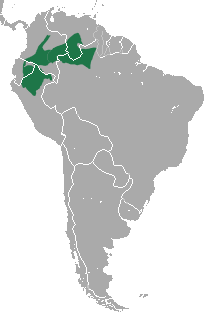White-bellied spider monkey facts for kids
Quick facts for kids White-bellied spider monkey |
|
|---|---|
 |
|
| Ateles belzebuth in Buenos Aires Zoo. | |
| Conservation status | |
| Scientific classification | |
| Genus: |
Ateles
|
| Species: |
belzebuth
|
 |
|
| White-bellied spider monkey range | |
The white-bellied spider monkey (Ateles belzebuth) is a type of spider monkey that lives in the Amazon Rainforest. It is also known as the white-fronted or long-haired spider monkey. Sadly, it is an endangered animal.
These monkeys live in the northwestern Amazon. You can find them in countries like Colombia, Ecuador, Venezuela, Peru, and Brazil. They have a whitish belly and a light patch on their forehead. This patch is often orange-buff, which might be from dirt.
White-bellied spider monkeys live in large groups of 20 to 40 individuals. When they are active, they split into smaller parties of 1 to 9 monkeys. People in Colombia call them mono prieto, mico prieto, or marimonda.
Over the last 45 years, their population has dropped by about half. This is mainly because their homes are being destroyed and because of hunting. Because of this, the IUCN lists them as endangered.
Contents
Life in the Wild
White-bellied spider monkeys are very important for spreading seeds. They help many fruit-bearing plants grow in new places. For example, they are key in spreading the seeds of a palm tree called Oenocarpus bataua.
These monkeys often use a large area of land. They also have several different trees where they sleep. They often drop seeds of their favorite fruits below these sleeping trees.
Social Life
White-bellied spider monkeys live in social groups that change a lot. These groups often split into smaller subgroups. These smaller groups travel, eat, and sleep together. Their makeup can change many times a day.
The size of these smaller groups can depend on the female monkeys. Females are usually more independent than males. However, females with babies are more likely to join a larger group. Females also tend to stay in smaller areas within their home territory with their young. Males, though, explore more of their home range.
The monkeys use loud calls to bring their subgroups back together. These calls can be heard from up to a kilometer away! Males in these groups are usually closely related to each other.
Reproduction
White-bellied spider monkeys usually become adults between 4 and 5 years old. Females typically have one baby at a time. However, there have been rare reports of twins.
Their pregnancy lasts about 226 to 232 days. Sometimes, male monkeys have been seen harming young monkeys. All the young monkeys that were harmed were from the same social group as the attackers.
What They Eat
The diet of White-bellied spider monkeys is mostly fruit, about 83% of what they eat. They are very important for spreading the seeds of many fruit trees. They carry many whole seeds in their stomachs. They also eat a lot of fruit pulp compared to other monkeys.
These monkeys are not picky eaters when it comes to fruit. They seem to like fruits that are high in fat or sugar. They also prefer fruits from trees that produce a lot of fruit. Sometimes, they will eat other plant parts like leaves, flowers, and bulbs. Very rarely, they might eat small insects. They have also been seen eating soil, which is called geophagy.
How They Move
White-bellied spider monkeys are amazing at moving through trees. They swing from branch to branch using their arms. This is called semi-brachiation. Their shoulder blades are placed high on their back. This allows them to move their arms very freely for swinging.
Their tail is also very special. It can grasp branches like an extra hand. It has a hairless, gripping pad at the end. This pad works like a finger, helping them hold onto surfaces. They have about 31 tail bones, which is more than some other monkeys. This long, strong tail helps them swing efficiently.
Their hands are also curved with long bones. This makes it easy for them to swing. Unlike most other primates, they do not have an outside thumb.
Images for kids
See also
 In Spanish: Mono araña común para niños
In Spanish: Mono araña común para niños



